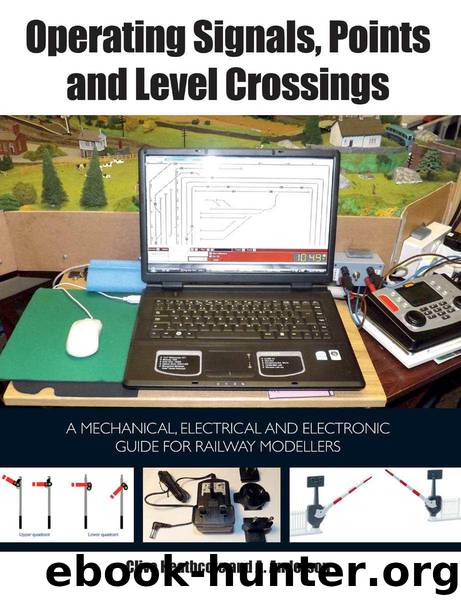Operating Signals, Points and Level Crossings: A Mechanical, Electrical and Electronic Guide for Railway Modellers by Heathcote Clive & Anderston Annie

Author:Heathcote, Clive & Anderston, Annie [Heathcote, Clive]
Language: eng
Format: azw3
ISBN: 9781847978646
Publisher: Crowood
Published: 2014-10-30T16:00:00+00:00
Extension wires being attached to a two-aspect signal. The green wire’s joint has been covered in heat shrink. There is an unshrunk piece of heat shrink ready to be put over the joint of the red wire to cover the joint, resistor and original red heat shrink placed by the signal manufacturer. As well as preventing bare joints shorting together, the heat shrink gives the joint extra mechanical strength.
The photograph here shows how to connect the enamelled wire to 7/0.7mm wire (seven strands of 0.7mm diameter each), which is thick enough for currents up to 1.4A and commonly used by railway modellers. After stripping the insulation, the 7/0.7 wire can be wound around the leg of the resistor. Twist the strands together first, as individual strands have a tendency to splay out when soldered. Twisting the wire around the resistor leg keeps it firmly in place while soldering. This prevents the joint being weakened by the resistor leg and the wire moving before the joint has cooled.
It is best to insulate all the bare metal to prevent different wires touching. This can be done with heat shrink as shown in the photograph, where 2.4mm heat shrink was used. Slip a length of heat shrink over the joint and then heat it up with a hot air gun. The heat shrink will shrink to up to half its original diameter. The signal’s common wire has no resistor and you may also wish to remove the resistors from the other wires if the signal is being used with a control board with built-in resistors, such as the MAS-Sequencer. In this case, wrap the thinner enamelled wire around the stripped twisted 7/0.7 wire. The heat of the solder will remove the enamel from the wire at the joint. Again insulate with heat shrink. If you do not possess a hot air gun, you can get away with heating the heat shrink tubing with a soldering iron or match. A hairdryer does not get hot enough to do this job. An acceptable but less satisfactory way to insulate the joint would be to wrap insulating or adhesive tape around it.
WIRING A SIMPLE SWITCH FOR A TWO-ASPECT LED SIGNAL
A two-aspect colour light signal can be controlled with a single pole, double throw switch sometimes called a changeover switch. These switches are moved by levers and are collectively known as toggle switches.
Signals using LEDs need DC type power and only light when the current flows in one direction, not the other. AC type power can damage LED signals. If an AC power supply is the only one available, it can be converted to DC by using a diode. (For further explanation, see Chapter 8.)
Download
This site does not store any files on its server. We only index and link to content provided by other sites. Please contact the content providers to delete copyright contents if any and email us, we'll remove relevant links or contents immediately.
| Dollhouses | Dolls & Doll Clothing |
| Miniatures | Model Trains |
| Models | Stuffed Animals |
| Toymaking | Wood Toys |
On Writing A Memoir of the Craft by Stephen King(4864)
The Doodle Revolution by Sunni Brown(4690)
A Simplified Life by Emily Ley(4099)
Mummy Knew by Lisa James(3637)
Marijuana Grower's Handbook by Ed Rosenthal(3623)
Better Homes and Gardens New Cookbook by Better Homes & Gardens(3529)
Figure Drawing for Artists by Steve Huston(3384)
Paper Parties by Erin Hung(3373)
Draw Your Day by Samantha Dion Baker(3292)
The Genius of Japanese Carpentry by Azby Brown(3228)
Japanese Design by Patricia J. Graham(3112)
The Code Book by Simon Singh(3077)
Dangerous Girls by Haas Abigail(2981)
Lions and Lace by Meagan Mckinney(2926)
The Curated Closet by Anuschka Rees(2915)
How to Make Your Own Soap by Sally Hornsey(2833)
The Checklist Manifesto by Atul Gawande(2782)
The Wardrobe Wakeup by Lois Joy Johnson(2733)
Zero to Make by David Lang(2727)
